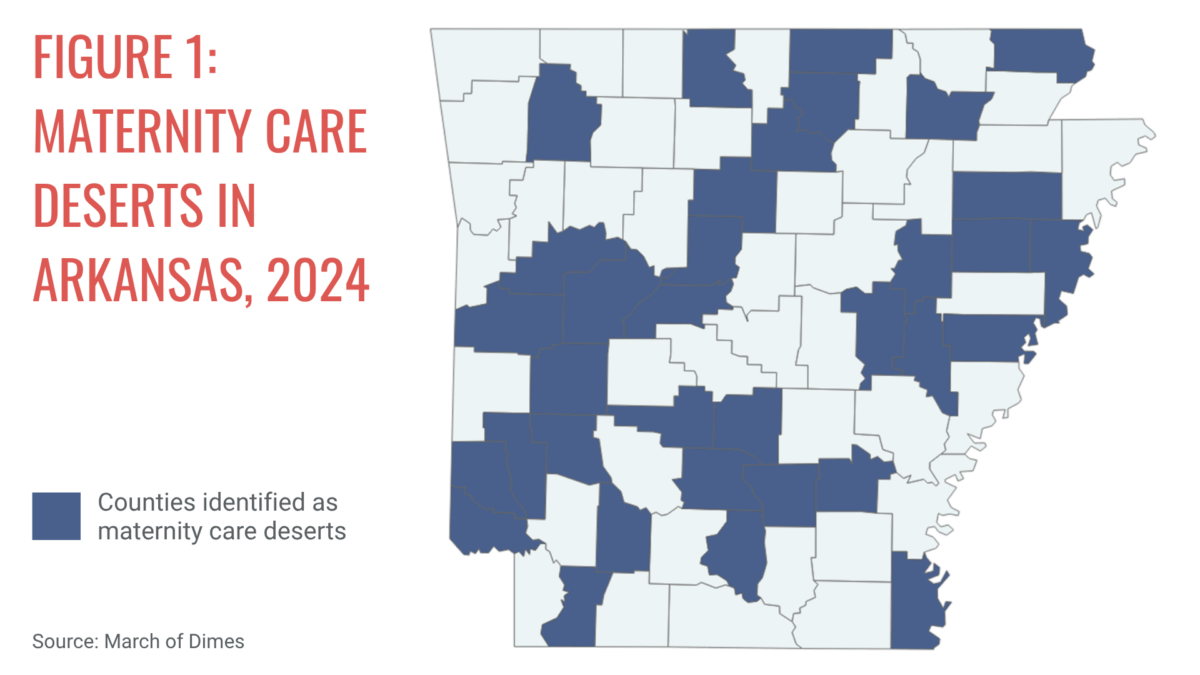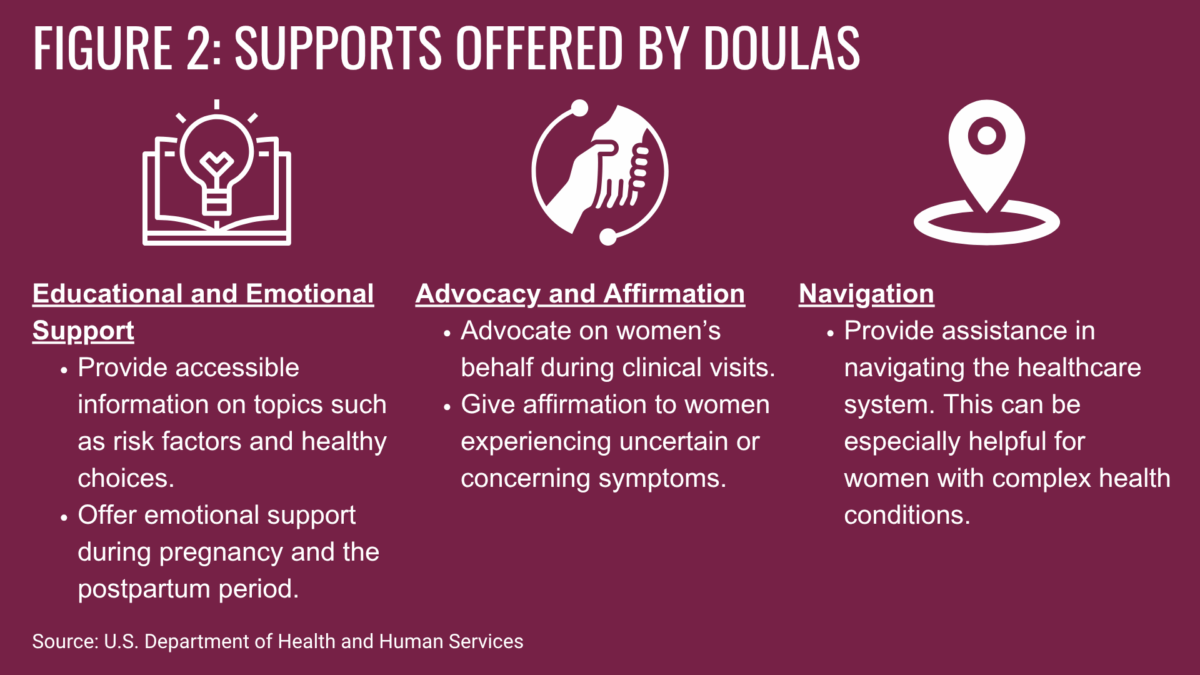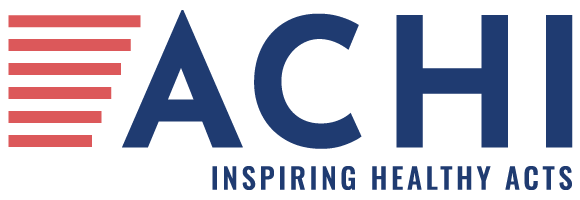Author
Elizabeth (Izzy) Montgomery, MPA
Health Policy Analyst
Contact
ACHI Communications
501-526-2244
jlyon@achi.net
The birthing journey represents perhaps the most transformative and vulnerable phase of a mother’s life. Unfortunately, many women find themselves navigating this stage of life without adequate familial and social supports, which can impact health outcomes.[1] Other challenges, including inadequate health literacy and limited access to maternity care, are also associated with poor maternal and infant health outcomes.[2] In Arkansas, there are 34 counties deemed “maternity care deserts” — counties without hospitals or birthing centers offering obstetric care or without any obstetric providers — limiting access to much-needed perinatal supports.[3]

Governmental and institutional efforts are underway to provide more comprehensive services for pregnant women and their families, with the goal of improving maternal health outcomes.[4] These include efforts to develop training opportunities and provide financial support for doulas, professionals who are trained in childbirth and who provide educational, emotional, physical, and other supports to pregnant or recently pregnant women throughout the perinatal experience. In Arkansas, the 2025 regular legislative session brought key wins for doula advocates, with the state establishing a certification process for community-based doulas and a reimbursement path for doula services through the state’s Medicaid program and private insurers.
This explainer explores the role of doulas in the birthing journey, doula training and certification requirements, evidence of outcomes associated with doula services, insurance coverage for doula care, and other efforts to support the expansion of doula services.

Background, Training, and Certification
Doulas have been defined as “non-clinical caregivers who provide physical, emotional and informational support to pregnant people and their partners before, during, and after childbirth.”[5] Doulas are primarily known for providing active support during the labor process, but they have increasingly taken on other important roles throughout the perinatal period (see Figure 2).
Doulas provide services either in private settings such as the home or in clinical settings. Community-based doulas — a term used to describe doulas who practice in their own communities and reflect the makeup of their communities — can provide culturally appropriate support to pregnant women who are at greater risk for poor maternal health outcomes.[6]

In contrast to licensed healthcare professionals, there is no standardized legal training requirement for doulas. Doula training and certification requirements vary significantly depending on a number of factors, including whether a state Medicaid program sets standard requirements to receive reimbursement (see the Coverage of Services section for more details). There are established doula certification programs such as DONA (Doulas of North America) International and the Childbirth and Postpartum Professional Association that have specific program requirements.[7],[8] Certificate programs for doulas typically require caregivers to complete a certain number of training hours and attend a certain number of births to qualify for certification.
Doula Services: Evidence on Outcomes and Birthing Experience
Numerous studies have explored the impacts of doula services on maternal and infant health outcomes. An updated Cochrane review published in 2017 examined evidence from 27 randomized controlled trials of nearly 16,000 women who received continuous support[a] during childbirth. The review found that women who received continuous support were more likely to have spontaneous vaginal births and shorter labors, and were less likely to report negative birth experiences, undergo cesarean (C-section) births, and have low five-minute Apgar scores (Apgar is a standardized assessment given to newborns one minute after birth and again five minutes after birth that allows a physician to estimate the newborn’s condition, with a higher score indicating a healthier condition). The review found the most benefits when continuous support was provided by a doula versus a member of the hospital staff or the birthing woman’s social network.[9]
Other studies have shown that doulas offer effective interventions in addressing racial and ethnic disparities experienced by many women of color. One study found that among a population of mostly non-Latina Black mothers living in a project area in Brooklyn, New York, those who were enrolled in the Healthy Start By My Side program, which provides doula support, experienced lower rates of preterm birth and reduced rates of low-birthweight babies compared to mothers who were not enrolled in the program.[10] Another study analyzed data from a statewide, population-based survey of women who gave birth in California and found that women were more likely to report receiving respectful care during childbirth when supported by a doula compared to women without such support. When survey data were analyzed by race and ethnicity, the association between receiving doula support and reporting respectful care was found to be highest among non-Hispanic Black women and Asian/Pacific Islander women.[11]
Studies have also explored the impacts of doula care on childbirth outcomes among Medicaid recipients. One study compared birth outcomes among Medicaid beneficiaries whose labor and delivery were supported by a doula care program in Minneapolis, Minnesota, to women who had Medicaid-funded births nationally. The C-section rate was 22.3% among doula-supported births compared to 31.5% among Medicaid beneficiaries nationally, and after controlling for clinical and sociodemographic factors, the researchers found that the odds of C-section delivery were 40.9% lower for doula-supported births.[12]
Coverage of Services
Historically, most private and public health insurance plans have not covered doula services, limiting access to these supports to those who could afford to pay out of pocket. However, many state Medicaid programs now provide reimbursement for doula services, and others are in the process of implementing policies to allow reimbursement. Additionally, some self-insured and private payers are beginning to cover doula services.
MEDICAID
As of June 2025, at least 23 states — Arizona, California, Colorado, Florida, Illinois, Kansas, Maryland, Massachusetts, Michigan, Minnesota, Missouri, New Jersey, New Mexico, Nevada, New York, Ohio, Oklahoma, Oregon, Pennsylvania, Rhode Island, South Dakota, Virginia, and Washington — and the District of Columbia provide reimbursement for doula services in Medicaid. An additional eight states are in the process of implementing doula reimbursement: Arkansas, Connecticut, Delaware, Montana, New Hampshire, Tennessee, Utah, and Vermont.[13],[14] Efforts in four of the states currently reimbursing for doula services are highlighted in Table 1.
TABLE 1: EXAMPLES OF STATE MEDICAID PROGRAM REIMBURSEMENT AND BENEFIT DESIGN FOR DOULAS SERVICES13,14
| State | Program Summary | Number of Covered Visits | Reimbursement Rates | Training or Credentialing Requirements |
|---|---|---|---|---|
| Maryland | • Doula services are covered for eligible Medicaid enrollees under a state plan amendment. • Program was initially funded for only four years, but legislation passed in May 2022 to make program permanent. • Benefit was effective January 1, 2022. | • Eight total prenatal and postpartum visits are covered per pregnancy. • Up to four visits allowed for prenatal care and up to four visits allowed for postpartum care. | • Prenatal care is reimbursed at $16.62 per 15-minute increment, with up to four units per visit. • Labor and delivery services are reimbursed at a flat rate of $800 (state increased rate from $350 to $800 in 2023). • Postpartum care is reimbursed at $19.62 per 15-minute increment, with up to four units per visit. | • Doulas must maintain up-to-date certification through a certification program and carry adequate liability insurance. • Medicaid program accepts certification from specified list of doula programs. |
| New Jersey | • Doula services are covered for eligible Medicaid enrollees under a state plan amendment. • Benefit was effective January 1, 2021. | • Eight total visits and labor support are covered for those qualifying for standard doula care. • 12 visits and labor support are covered under enhanced doula benefit for beneficiaries age 19 or under. | • Standard doula care benefit are reimbursed up to a total of $1,065. • Enhanced doula care benefit are reimbursed up to a total of $1,331. • A $100 incentive is also available for a postpartum follow-up visit for both levels of care. • Delivery services are reimbursed at a flat rate of $500. | • Doulas must be at least 18, pass a background check, and carry liability insurance. • Doulas must complete training through a program approved by the state Department of Human Services. • Training includes required core competencies, including perinatal counseling, infant care, and labor support. • Doulas are also required to receive community-based/cultural competency and HIPAA training and receive adult and infant CPR certification. |
| Nevada | • Doula services are covered for eligible Medicaid enrollees under a state plan amendment. • Benefit was effective April 1, 2022. | • Six total prenatal and postnatal visits are covered per pregnancy. | • Prenatal and postnatal care visits are reimbursed at a rate of $100 each (state increased rate from $50 to $100 in 2024). • Labor and delivery services are reimbursed at a flat rate of $900 (state increased rate from $150 to $900 in 2024). • An additional 10% incentive is available for doulas providing care in rural areas. | • Doulas must be certified by the Nevada Certification Board to be eligible for reimbursement. The board maintains a list of certification requirements for doulas. • Doulas must also enroll as individual Medicaid providers. |
| Oklahoma | • Doula services are covered for eligible Medicaid enrollees under a state plan amendment. • Benefit was effective July 1, 2023. | • Eight total prenatal and postnatal visits are covered per pregnancy. • Prenatal and postnatal visits must be at least 60 minutes and may be conducted via telehealth. • Labor and delivery support is also covered and must be provided in person. | • Prenatal and postnatal care visits are reimbursed at a rate of $64.45 per visit. • Reimbursement rates for labor and delivery vary by delivery type: -Cesarean delivery-only visit: $325.45 -Vaginal delivery only: $468.55 -Vaginal delivery after previous cesarean delivery: $527.78 -Cesarean delivery following vaginal delivery attempt: $546.50 | • Doulas are required to be at least 18 years old and obtain a National Provider Identifier. • Doulas must have at least one certification as a birth, postpartum, full-spectrum, or community-based doula. • Medicaid program requires certification to be obtained from a list of eligible certifying organizations. |
A 2023 Medicaid and CHIP Payment and Access Commission report included interviews with doulas and state Medicaid representatives on doula benefit use and challenges.[15] Barriers to implementation and utilization of doula benefits include lack of beneficiary awareness, workforce issues (such as a limited number of doulas participating in Medicaid or the absence of a community-representative doula workforce), and administrative hurdles for doulas seeking to become Medicaid providers. Some states have worked to address these challenges by actively involving doulas from historically marginalized backgrounds in discussions with Medicaid officials, including doulas serving populations with higher rates of poor maternal and infant health outcomes. Other states have worked to address administrative barriers for doulas, including New Jersey, which created paid positions within its Medicaid agency to offer individual support to doulas wanting to enroll as Medicaid providers.
ARKANSAS’S RECENT DOULA EFFORTS
Act 965 of 2025 establishes a certification process for community-based doulas and mandates reimbursement of doula services by Arkansas Medicaid and private insurers.[16] The law allows the Arkansas Department of Health (ADH) to certify a doula who is at least 18 years old and has obtained certification from the Doula Alliance of Arkansas or another organization designated by ADH. The law directs ADH to collaborate with the Doula Alliance of Arkansas in the establishment of criteria to designate certifying organizations. State certification is valid for two years but can be renewed if the doula completes 10 hours of professional development during that two-year period. ADH is also charged with creating and maintaining a publicly accessible registry of certified doulas.
Additionally, Act 965 outlines scope of practice requirements for certified community-based doulas, specifying that they may perform only the following services: providing childbirth education; helping pregnant women navigate the healthcare system; advocating for pregnant women before, during, and after birth; connecting pregnant women with resources; and providing continuous emotional and physical support through labor and birth and intermittently during the prenatal and postpartum periods.
Act 965 also establishes a reimbursement path for certified, community-based doula services through Arkansas Medicaid and private insurers. On or before December 31, 2025, the Arkansas Department of Human Services must promulgate rules on doula reimbursement in Medicaid.
PRIVATE AND SELF-INSURED PAYERS
As of April 2025, two states (Louisiana and Rhode Island) required coverage of doula services by private insurers. Five additional states (Arkansas, Colorado, Delaware, Illinois, and Virginia) are in the process of implementing a requirement for private insurers to cover doula services.[17] In 2021, Rhode Island became the first state to implement a doula coverage requirement for fully insured commercial plans. Under the law, each plan may define coverage for the doula benefit as it relates to reimbursement, credentialing, and contracting requirements. One plan, offered by Blue Cross and Blue Shield of Rhode Island, covers up to six total prenatal and postnatal visits, along with labor and delivery services, for eligible members, with up to $1,500 reimbursable for doula care.[18]
A self-insured employer, Arkansas-headquartered retail giant Walmart, began piloting doula services for its employees in Georgia, Louisiana, Indiana, and Illinois in 2021. In October 2023, the company announced that the doula service benefit would be expanded nationwide. The company requires that doulas be credentialed through either DONA International or the National Black Doulas Association.[19]
OTHER FEDERAL AND STATE DOULA COVERAGE EFFORTS
TRICARE — a healthcare program of the U.S. Department of Defense that provides civilian health coverage for U.S. Armed Forces military personnel, retirees, and their dependents — began providing coverage for doula services through a pilot demonstration that began January 1, 2022, and will continue through December 31, 2026. TRICARE covers up to six visits by a certified labor doula, which can be used prior to and after birth. A separate visit is also covered for labor and delivery support.[20]
The federal Health Resources and Services Administration (HRSA) has provided funding to support doula services and workforce expansion through the Healthy Start program, which aims to improve health outcomes before, during, and after pregnancy in communities with high rates of poor maternal health and infant mortality.[21] In 2021, HRSA launched a supplemental funding opportunity for Healthy Start program awardees to increase the availability of doulas in Healthy Start service areas disproportionately affected by infant and maternal mortality.
The University of Arkansas for Medical Sciences (UAMS) has received HRSA funding through the Healthy Start Community Based Doula Awards to support the Healthy Start-Jined Ilo Kobo program, which assists Marshallese clients in Northwest Arkansas. The program has recruited and trained seven community-based doulas to provide prenatal, birthing, and postpartum support to Healthy Start clients. Since 2021, the doulas have served 124 Healthy Start clients enrolled in the program (Moore, S., personal communication, December 19, 2023). The UAMS Institute for Community Health Innovation is working to increase the doula workforce in Arkansas by training 80 doulas through a program administered in partnership with Ujima Maternity Network and Birthing Beyond. The program includes a scholarship which covers the full cost of training and is available to individuals throughout the state.[22]
In December 2023, the Centers for Medicare and Medicaid Services (CMS) Innovation Center announced the Transforming Maternal Health (TMaH) Model, which supports participating state Medicaid agencies in developing a whole-person approach to pregnancy, childbirth, and postpartum care.[23] The whole-person approach will address physical, mental, and social needs experienced during pregnancy, with the goal of improving outcomes and healthcare experiences for mothers and newborns while reducing overall program expenditures. The model aims to improve access, infrastructure, and workforce capacity in maternal health care, with increased access to perinatal community health workers and doulas a key part of that effort. Arkansas was one of the states awarded the TMaH grant and will receive $17 million in funding to support maternal health initiatives in the state.[24]
Community health workers — frontline public health workers who are trusted members of or have an unusually close relationship with the community served — also play an important role in the development of community-based maternal supports. Community health workers can complement services provided by doulas by helping pregnant and postpartum women navigate the healthcare system and addressing health-related social needs such as housing, transportation, and food needs.[25]
Conclusion
Doulas can play a key role in providing educational, physical, emotional, and informational support throughout the birthing journey. Evidence has demonstrated the positive impact of doula support in reducing C-section rates, improving birth experiences, and helping to address racial and ethnic disparities. While many states, including Arkansas, provide or are working to provide Medicaid reimbursement for doula services, barriers persist, including limited awareness and workforce challenges. Private payers and self-insured payers are increasingly recognizing the value of doula support, including Walmart with its nationwide expansion of a doula benefit for its workforce. Federal initiatives, including HRSA’s support for doula services through the Healthy Start program and CMS’ launch of the TMaH Model, also signal a growing recognition of the importance of comprehensive maternal support and the potential to impact outcomes.
References
[a] The Cochrane review defined continuous support as “support provided from at least early labor (or within one hour of hospital admission), through until at least the birth, and provided by a person whose sole responsibility is to provide support to the woman.”
[1] Cho, H., Lee, K., Choi, E., Cho, H. N., Park, B., Suh, M., Rhee, Y., & Choi, K.S. (2022). Association between social support and postpartum depression. Scientific Reports, 12(1), 3128. https://doi.org/10.1038/s41598-022-07248-7
[2] Yee, L. M., Silver, R., Haas, D. M., Parry, S., Mercer, B. M., Wing, D. A., Reddy, U., Saade, G. R., Simhan, H., & Grobman, W. A. (2021). Association of health literacy among nulliparous individuals and maternal and neonatal outcomes. JAMA Network Open, 4(9), e2122576. https://doi.org/10.1001/jamanetworkopen.2021.22576
[3] March of Dimes. March of Dimes maternity care deserts dashboard. Accessed June 19, 2025. https://www2.deloitte.com/us/en/pages/life-sciences-and-health-care/articles/march-of-dimes-maternity-care-deserts-dashboard.html
[4] The White House. (2022, June). White House blueprint for addressing the maternal health crisis. https://bidenwhitehouse.archives.gov/wp-content/uploads/2022/06/Maternal-Health-Blueprint.pdf
[5] March of Dimes. (2022, March 29). Doulas can improve care before, during, and after childbirth. https://www.marchofdimes.org/find-support/blog/doulas-can-improve-care-during-and-after-childbirth
[6] Knocke, K., Chappel, A., Sugar, S., De Lew, N., & Sommers, B.D. (2022, December 13). Doula care and maternal health: An evidence review. ASPE Office of Health Policy. https://aspe.hhs.gov/sites/default/files/documents/dfcd768f1caf6fabf3d281f762e8d068/ASPE-Doula-Issue-Brief-12-13-22.pdf
[7] DONA International. Birth doula certification. Accessed June 19, 2025. https://www.dona.org/become-a-doula/birth-doula-certification
[8] CAPPA. Training and certification. Accessed June 19, 2025. https://cappa.net/training-certification/
[9] National Partnership for Women & Families. (2018). Continuous support for women during childbirth: 2017 Cochrane review update key takeaways. The Journal of Perinatal Education, 27(4):193–197. https://doi.org/10.1891/1058-1243.27.4.193
[10] Thomas, M. P., Ammann, G., Brazier, E., Noyes, P., & Maybank, A. (2017) Doula services within a Healthy Start program: Increasing access for an underserved population. Maternal and Child Health Journal, 21(Suppl 1):59–64. https://doi.org/10.1007/s10995-017-2402-0
[11] Mallick, L. M., Thoma, M. E., & Shenassa, E. D. (2022). The role of doulas in respectful care for communities of color and Medicaid recipients. Birth, 49(4):823–832. https://doi.org/10.1111/birt.12655
[12] Kozhimannil, K. B., Hardeman. R. R., Attanasio, L. B., Blauer-Peterson, C., & O’Brien, M. (2013). Doula care, birth outcomes, and costs among Medicaid beneficiaries. American Journal of Public Health, 103(4):e113–e121. https://doi.org/10.2105/ajph.2012.301201
[13] Hasan, A. (2024, April 16). State Medicaid approaches to doula service benefits. National Academy for State health Policy. https://nashp.org/state-medicaid-approaches-to-doula-service-benefits/
[14] National Health Law Program. Doula Medicaid Project. Accessed June 19, 2025. https://healthlaw.org/doulamedicaidproject/#current-efforts-at-expanding-access-to-doula-care
[15] Medicaid and CHIP Payment and Access Commission. (2023, November). Doulas in Medicaid: Case study findings. https://www.macpac.gov/wp-content/uploads/2023/11/Doulas-in-Medicaid-Case-Study-Findings.pdf
[16] Arkansas Act 965 of 2025. https://arkleg.state.ar.us/Home/FTPDocument?path=%2FACTS%2F2025R%2FPublic%2FACT965.pdf
[17] Herbert. K. (2025, April 21). Private insurance coverage of doula care: Spring 2025 state of the states. National Health Law Program. https://healthlaw.org/private-insurance-coverage-of-doula-care-spring-2024-state-of-the-states/
[18] Chen, A., & Rohde, K. (2023, March 14). Private insurance coverage of doula care: A growing movement to expand access. National Health Law Program. https://healthlaw.org/private-insurance-coverage-of-doula-care-a-growing-movement-to-expand-access-2/
[19] Woods, L. (2023, October 24). Walmart accelerates family building support for associates by expanding doula services nationwide. https://corporate.walmart.com/news/2023/10/24/walmart-accelerates-family-building-support-for-associates-by-expanding-doula-services-nationwide
[20] TRICARE. TRICARE Childbirth and Breastfeeding Support Demonstration. Accessed June 19, 2025. https://www.tricare.mil/CBSD
[21] Health Resources and Services Administration. Healthy Start. Accessed June 19, 2025. https://mchb.hrsa.gov/programs-impact/healthy-start
[22] Wise. D. (2025, January 7). UAMS, partners offer comprehensive doula training. University of Arkansas for Medical Sciences. https://news.uams.edu/2025/01/07/uams-partners-offer-comprehensive-doula-training/
[23] Centers for Medicare and Medicaid Services. Transforming Maternal Health (TMaH) Model. Accessed June 19, 2025. https://www.cms.gov/priorities/innovation/innovation-models/transforming-maternal-health-tmah-model
[24] Arkansas Department of Human Services. (2025, January 6). Arkansas awarded $17M grant to support maternal health initiatives. https://humanservices.arkansas.gov/news/arkansas-awarded-17m-grant-to-support-maternal-health-initiatives/
[25] Bakst, C., Moore, J. E., George, K. E., & Shea, K. (2020, May). Community-based maternal support services: The role of doulas and community health workers in Medicaid. Institute for Medicaid Innovation. https://medicaidinnovation.org/wp-content/uploads/2022/09/2020-IMI-Community_Based_Maternal_Support_Services-Report.pd







